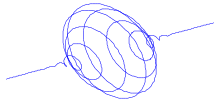莫莱小波


在数学上,莫莱小波(Morlet wavelet)或加博尔小波(Gabor wavelet)是一种由复数指数(载波)乘以高斯窗(包迹)组成的小波。 这种小波和人类的感知相关,包含视觉以及听觉。
历史
[编辑]在1946年,物理学家加博尔·德奈什从量子物理学提出了想法,介绍了高斯窗对于时频分解的使用,这方法他称为原子。而此方法可以提供在空间和频率解析的最佳平衡。这些方法被用在加博尔转换。加博尔转换是一种短时间傅里叶转换。在1984年,让·莫莱在地震学社区引用了加博尔的方法,连同皮埃尔·古皮约(Pierre Goupillaud)和亚历克斯·格罗斯曼(Alex Grossman)修改它去保持相同小波形状上等同于八度间隔。使其成为连续小波转换的第一个正规化。
定义
[编辑]此小波被定义为平面波减去常数后,通过高斯窗局域化的结果:[1]
由标准定义而正常化常数 为:
莫莱小波的傅里叶转换为:
中心频率 的位置在 的最大值,在此情况,解法为下列的方程:
在莫莱小波中的参数 允许在时间和频率解析中交换。通常, 的限制是用于避免莫莱小波的参数 太低对时间分辨率产生的影响。
在只有缓慢变动的频率和振福调变(例如音频)的讯号中,是不需要使 很小。在这个情况下,变得非常小() ,因此常常忽视。在 的限制下,莫莱小波的频率常常采取。
小波存在着复数版本或是纯实数版本,称为实莫莱小波(real Morlet)和复莫莱小波(complex Morlet)[2];也有人称复数版为加博尔小波(Gabor wavelet),实数版为莫莱小波(Morlet wavelet)。[3][4]
Matlab函数
[编辑][PSI,X] = morlet(LB,UB,N) 回传Morlet wavelet在[LB,UB]区间N点的值。
输出参数为在网格X上计算的小波函数PSI和网格X。
这个小波有[-4,4]的有效支撑。虽然[-4,4]是有正确理论支撑,但更宽的有效支撑[-8,8]被使用在计算中,为的是提供更准确的结果。
医学上的应用
[编辑]莫莱小波转换方法提供了一个桥梁,能够使用频率和时间的讯息借由傅里叶转换来获得复杂的头部外伤谱。莫莱小波转换并非作为傅里叶转换的替代方案, 而是作为补充的角色。一个允许时间有关的变化定性访问且可用多个维度去感应衰减分析。
音乐上的应用
[编辑]莫莱小波转换可以用于音乐转录,且能产生非常准确的结果。这在只使用傅里叶转换是做不到的。莫莱小波转换能够捕捉重复和替代音符 的短脉冲。在莫莱转换中,每个音符都有一个明确的开始和结束时间。
心电图上的应用
[编辑]莫莱小波转换在心电图中的应用主要是为了区分异常的心跳行为。由于异常的心跳变化是一个非平稳的讯号,而这个讯号适用于小波的分析。
相关
[编辑]文献
[编辑]- ^ John Ashmead. Morlet Wavelets in Quantum Mechanics. Quanta. 2012, 1 (1): 58–70 [2016-01-21]. doi:10.12743/quanta.v1i1.5. (原始内容存档于2020-08-26).
- ^ Wavelet Families - MATLAB & Simulink. www.mathworks.com. [2023-03-12]. (原始内容存档于2019-08-10).
- ^ GaborWavelet—Wolfram 语言参考资料. reference.wolfram.com. [2023-03-12]. (原始内容存档于2023-03-12).
- ^ MorletWavelet—Wolfram 语言参考资料. reference.wolfram.com. [2023-03-12]. (原始内容存档于2023-03-12).
- P. Goupillaud, A. Grossman, and J. Morlet. Cycle-Octave and Related Transforms in Seismic Signal Analysis. Geoexploration, 23:85-102, 1984
- N. Delprat, B. Escudié, P. Guillemain, R. Kronland-Martinet, P. Tchamitchian, and B. Torrésani. Asymptotic wavelet and 加博尔 analysis: extraction of instantaneous frequencies. IEEE Trans. Inf. Th., 38:644-664, 1992
Text is available under the CC BY-SA 4.0 license; additional terms may apply.
Images, videos and audio are available under their respective licenses.













